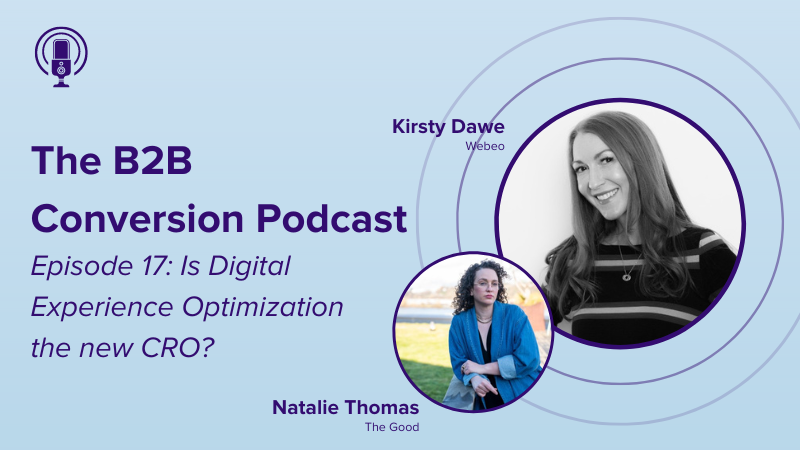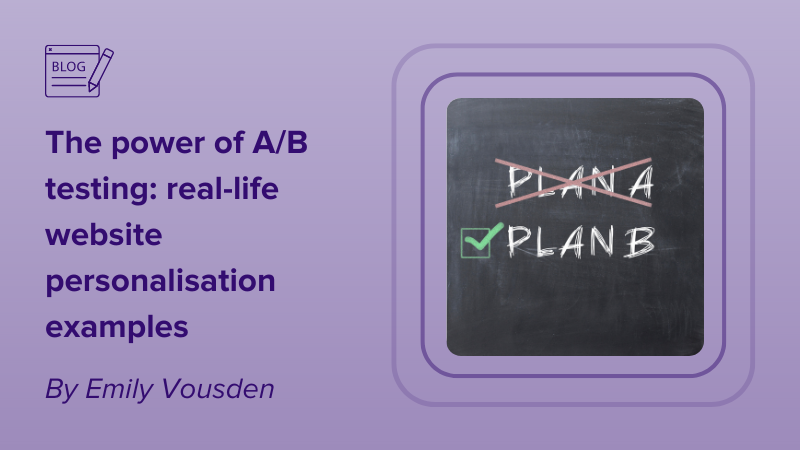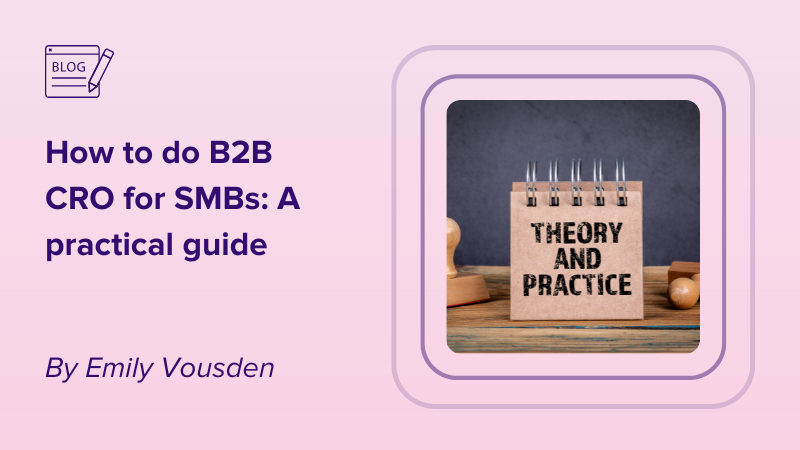Econsultancy found that 93% of brands using personalization have seen an uplift in their conversion rate thanks to website personalization. And, according to the results of the latest Webeo: Futures survey, conversion rate is considered in the top 3 success-measuring marketing metrics. So, if conversion rate optimization (CRO) is important to you, then it’s time to get personal. Discover how creating individual website experiences for your visitors will take your conversion rate up a notch.
Display relevant content
According to InstaPage, 74% of customers feel frustrated when website content is not personalized. If you’re hoping to convert website visitors into customers, then real-time content personalization needs to be on your radar. For B2B organizations in particular, personalized content should be a priority — when your target audience is made up of busy B2B buyers, you need to capture attention quickly. Putting relevant blog posts and downloadable content in front of their eyes will speed up the buyer journey and reassure them you are the right vendor to work with.
Personalized calls to action
Think about the calls to action on your website. Are they clear? Do they speak to your specific buyer? Consider the action they are about to take and the kind of language they are used to seeing in their industry. To effectively guide your site visitors through to the conversion stage, you need to ensure your CTAs meet their specific needs. It works too — HubSpot found that personalized calls to action perform 202% better than basic CTAs. Essentially, it creates a personalized service from start to finish.
Engaging imagery
According to Social Media Examiner, relevant imagery can help people retain 65% of the information they take on for up to three days, compared to just 10% when no imagery is used. This highlights just how important visuals are to consumers — especially relevant visuals. Will images of your own team, product or office be relevant to your website visitors? For the most dynamic personalization and likelihood of conversion, consider presenting potential customers with industry-specific, attractive imagery that resonates with them as an organization.
Industry-specific language
As marketers, we tend to use a lot of jargon. This can be seriously off-putting for potential buyers. Simplify what you are saying — and consider asking someone from outside of your industry to read copy before it’s posted. This way, brands can ensure they’re not over-complicating or using terminology that will scare visitors off. According to Statista, some of the most hated office jargon includes terms like ‘touch-base’ and ‘no-brainer’, so be sure to do your research. When it comes to digital personalization, you need to be clear, concise and use language that speaks directly to your target audience.
Greet visitors by name
Customizing your website’s welcome message will help you create the ultimate personalized homepage. When the user lands, they will know immediately that you value their visit and are ready to do business with them. This is a great way to complement an account-based marketing (ABM) strategy, ensuring every digital touchpoint is designed with the user in mind. But, this shouldn’t be the only personalized element — according to Econsultancy, only 8% of survey respondents said they’d be encouraged to engage if a brand addressed them by name.
Guide users based on buyer behavior
According to InMoment, half of loyal customers have left organizations for a more relevant competitor. Behavioral targeting is an effective way of creating relevance and guiding your customer through their buyer journey. From purchase behavior through to loyalty status, every customer acts differently as they make their way towards the purchase button. Use this to your advantage — tailor calls to action to hurry hesitant buyers along and display appropriate product recommendations to impulsive buyers who’ve used your services before.
Develop a wider personalized marketing strategy
Dynamic Yield found that for nearly 20% of marketers, personalization is still channel-specific. But, according to the E-Tailing Group, increasing personalization in more channels can increase overall consumer spending up to 500%. Streamlining your personalization strategy to incorporate multiple platforms, channels and strategies is crucial for success. In fact, when thinking about your user’s journey towards making a conversion, impersonal marketing content or experiences can be disruptive. Put your customer at the heart of your strategy, considering each element of the buyer journey.
Use product recommendation based on purchase behavior
Personalized recommendations have taken the B2C, ecommerce and streaming service world by storm. According to Barilliance, personalized product recommendations increase conversion rates. And, by placing product recommendations above the fold, they are almost twice as effective. So, conduct research, make the most of accurate data and recommend products or services your website visitors will love. The more relevant the products, the more likely your customers are to make purchases and improve conversion rates.
Be specific about location
There are a number of ways to split your audience for the most effective segmentation. Be sure to create a personalized user experience with location in mind. For example, when personalizing website greetings, you will need to consider time-zones, language and dialect. Similarly, a comprehensive understanding of the weather, political climate and cultural events is a necessity. Recommending office heaters to your dream client in December might seem like a good idea — but not if the visiting customer is based in Sydney.
Prioritize high-value, target market clients
With segmentation comes the ability to prioritize high-value clients or your target audience. When optimizing conversion rates, consider how valuable your potential customers are. How likely are they to convert? When planning or creating individualized experiences, ensure the visitors most likely to become customers are given the most bespoke, tailored experience. Customize each digital touchpoint to them specifically to ensure they make a conversion.
Upsell and cross-sell to existing customers
Your existing customers are your greatest asset. According to HubSpot, it can be up to 25x more expensive to acquire a new customer than it is to retain an existing one. So, consider implementing an upselling and cross-selling strategy to truly get the most out of your customer relationships. They’ll reap the rewards of a highly-personalized service, and you’ll benefit from their understanding and appreciation of your brand.
Test for success
Like all things in marketing, there is a level of experimentation required when creating individualized experiences. That’s why split testing should be included in your strategy. Something as simple as the color of a call to action button can make a difference to your website visitors. Experiment, monitor, measure and don’t be afraid to make changes where necessary. For the ultimate CRO, discover what your customers like and remember that will continue to change — so stay ahead and be prepared for trial and error.
Webeo is a leading website personalization software that creates bespoke onsite experiences for B2B organizations. Thanks to a global leading database of business IP addresses, Webeo tailors the appearance, content, language and imagery of your B2B website based on the user visiting. This way, you can impress every website visitor with the perfect website, every time. Greet the business by name, display content that resonates with them and show imagery that will capture their interest. Advance your CRO strategy, improve user experience and take your website to the next level. Discover the power of website personalization software and book your free demonstration today.




